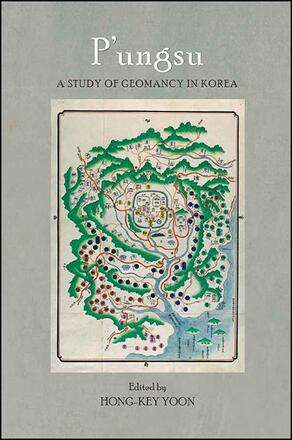List of Figures and Tables
Acknowledgments
PART I. Toward a History of Geomancy in Korea
An Overview of Its Development
1. Introduction: Historical and Cultural Studies of Geomancy in Korea
Hong-key Yoon
1 A Journey to the Collective Authorship of This Book
2 The Aim and Objectives of This Book
3 The Contents and Structure of This Book
4 Astro-Geomancy in Korea
5 The Definition of P’ungsu and Korean Geomancy
6 Why Geomancy Instead of Fengshui? The Roots of Western Academic Studies of Fengshui (Geomancy)
7 Review of Modern Research on Korean Geomancy
2. The Eight Periods in the History of Korean Geomancy
Hong-key Yoon
1 From the Time of Introduction to the Time toward the End of the Silla Dynasty before Tosŏn, the Geomancer-Monk (from the Ancient Era to the Ninth Century)
2 From the Time of Master Tosŏn to King Kojong of the Koryŏ Dynasty (from the Ninth Century to 1259)
3 The Paucity of Practicing Geomancy during the Mongol Domination (1231–1356)
4 From King Kongmin of the Koryŏ Dynasty, Post Mongol, to the Fourth King of the Chosŏn Dynasty, King Sejong (1351–1450)
5 From King Sejo (r. 1455–1468) to the Time before the Rise of Sirhak or the Practical Learning School (1670)
6 From the Sirhak School to the End of the Chosŏn Dynasty (1670–1910)
7 The Period of Japanese Colonial Rule (1910–1945)
8 From the Liberation (1945) to the Present
3. Geomancy and Major Social Upheavals (Armed Uprisings) in the History of Korea
Hong-key Yoon
1 The Myoch’ŏng Rebellion
2 The Hong Kyŏngnae Rebellion
3 Chŏn Pongjun and the Tonghak Peasants’ Movement
4 Summary Remarks on Geomancy and Social Upheavals
4. Government Affairs Relating to Geomancy during the Time of Premodern Korea
Hong-key Yoon
1 Government Examinations for Geomancers
2 Government Bureaus of Geomancy
3 Important Textbooks of Geomancy during the Chosŏn Dynasty
5. A Glimpse of Environmental Management through Geomancy in Korean History
Hong-key Yoon
1 Official Records on the Impact of Geomancy on Vegetation in Korean History
2 A Small Grove of Trees around a Commoner’s Grave as a Means of Environmental Management
3 Royal Graves and Conservation of Forest
4 Preference for Certain Trees in Geomancy for Cosmological Harmony
5 Geomancy and Forest Land Tenure
6 Serious Geomantic Debates on Water Pollution
6. Principal Characteristics of Korean Geomancy
Hong-key Yoon
1 Mainly Based on the Form (Landform-Landscape) School
2 Preoccupation with Grave Geomancy
3 Strong Belief in the Idea of Reinforcing Geomantic Conditions through Artificial Means or Sanch’ŏn Piboron
4 Close Association with Geomantic Prophecies or Chiri Toch’am 地理 圖讖
5 A Close Association with Social Upheaval (Armed Uprisings)
6 Chigi soewangnon—the Idea that the Vital Energy of an Auspicious Site Can Wane or Wax through Time
7 Significant Impact of Geomancy on Korean Cartography
PART II. Selected Topics in Korean Geomancy
Historical-Cultural Studies
7. Geomantic Practices of Water Acquisition and Management during the Chosŏn Dynasty
Dowon Lee
1 Background
2 Acquisition and Management of Water Resources
3 Conclusions
8. Geomantic Folk Narratives on the Bamboo Groves in Chinju City: Landscape as a Sign of Geomantic and Confucian Ideology
Kim Duk Hyun
1 Understanding the Groves of Traditional Korean Settlements
2 The Groves as Signifiers
3 The Formation of Geomantic Space and Groves in Chinju
4 Decline of Nam River Groves
5 Interpretation of the Significance of Settlement Groves
6 Conclusion
9. Geomancy and Traditional Architecture during the Chosŏn Dynasty
In-choul Zho
1 Introduction
2 Characteristics of Traditional Korean Architecture and Geomancy
3 Conclusion
10. Geomantic Aesthetics in a Traditional Korean Garden: With Reference to Kosan Yun Sŏndo’s Garden
Jongsang Sung
1 Introduction: Understanding Gardens through Geomancy
2 The Relationship between the Traditional Korean Garden and Geomancy
3 The Korean Garden as a Site of Geomantic Practices
4 Principles of Geomancy Applied to Traditional Korean Gardens
5 Geomancy as the Subject of Aesthetic Study: Geomantic Aesthetics
6 Reading the Korean Garden through Geomancy: Looking at the Puyongdong Wollim
7 Conclusion
11. Geomantic Landscape of a Sailing Boat: An Examination of Cultural Ecological Links
Hong-key Yoon
1 The Formation of Geomantic Landscapes
2 Types of Geomantic Landscapes in Korea
3 Geomantic Landscapes as a System Comparable to a Mini-Gaia
4 The Site Characteristics of the “Landscape of a Sailing Boat”
5 Concluding Remarks
12. Geomantic Modification of Landforms: The Idea of Chosan Pibo
Hong-key Yoon
1 Introduction
2 Previous Studies on P’ungsu and Chosan Pibo
3 The Three General Premises of the Geomantic Idea of Pibo
4 Historical Examples of Chosan Pibo
5 Characteristics of Chosan Pibo
6 The Significance of the Geomantic Idea of Pibo as a Geographic Agent in the History of Humanity
7 Conclusion
13. Geomancy and Psychology: A Psychological Analysis of Geomancy
Cheol Joong Kang
1 The Significance of a Psychological Study of Geomancy
2 Symbol and Psyche
3 Psychological Aspects of Auspicious Places
4 Reflective Remarks on a Psychological Analysis of Geomancy
5 Conclusion
14. Geomancy and Buddhism: An Examination of the Interaction during the Koryŏ Period
Won-suk Choi
1 Introduction
2 The Origin and Development of Interaction between Buddhism and Geomancy
3 Buddhism and Geomancy in Connection with Political Leadership
4 Mutually Beneficial Relationships between Buddhism and Geomancy
5 Conclusion
15. Geomantic Discourses of the Chosŏn Confucian Literati
Hwa Lee
1 Geomancy Discourse of the Chosŏn Royal Court: “Unbelievable but Indisposable”
2 Chinese Confucian Predecessors’ Geomancy Practical Index
3 Confucian Scholar-Officials’ Adoption of Geomancy
4 Reasons for the Adoption of Geomancy: Its Economic Aspects and Burial Site Litigations 山訟
5 Conclusion
16. Geomantic Ideas in T’aengniji Manuscripts: An Examination of Changing Perceptions of P’ungsu during the Late Chosŏn Dynasty
Inshil Choe Yoon
1 Why T’aengniji Manuscripts?
2 Constant Features of Geomancy
3 Changes in Geomantic Discourses over Time
4 Conclusion
17. Concluding Remarks and Reflections
Hong-key Yoon
References
List of Contributors
Index
